Business Management Report: HRM, Motivation, Operations and Quality
VerifiedAdded on 2023/01/05
|13
|3920
|82
Report
AI Summary
This Business Management report provides an in-depth analysis of various key areas, including Human Resource Management (HRM), Leading by Motivation, Managing Operations, and Quality. The report explores critical issues in HRM, such as efficiency, effectiveness, and performance assessment, using BMW as a case study. It examines HRM practices like incentives and skill development and analyzes the impact of organizational changes and performance reviews. The report also discusses McGregor's Theory X and Theory Y, Maslow's hierarchy of needs, and Herzberg's hygiene and motivating factors in relation to employee motivation. Furthermore, it delves into psychological contracts and explores how these concepts influence the employer-employee relationship. The assignment fulfills the requirements of the UGB224 Business Management module, offering a comprehensive overview of essential business management principles.
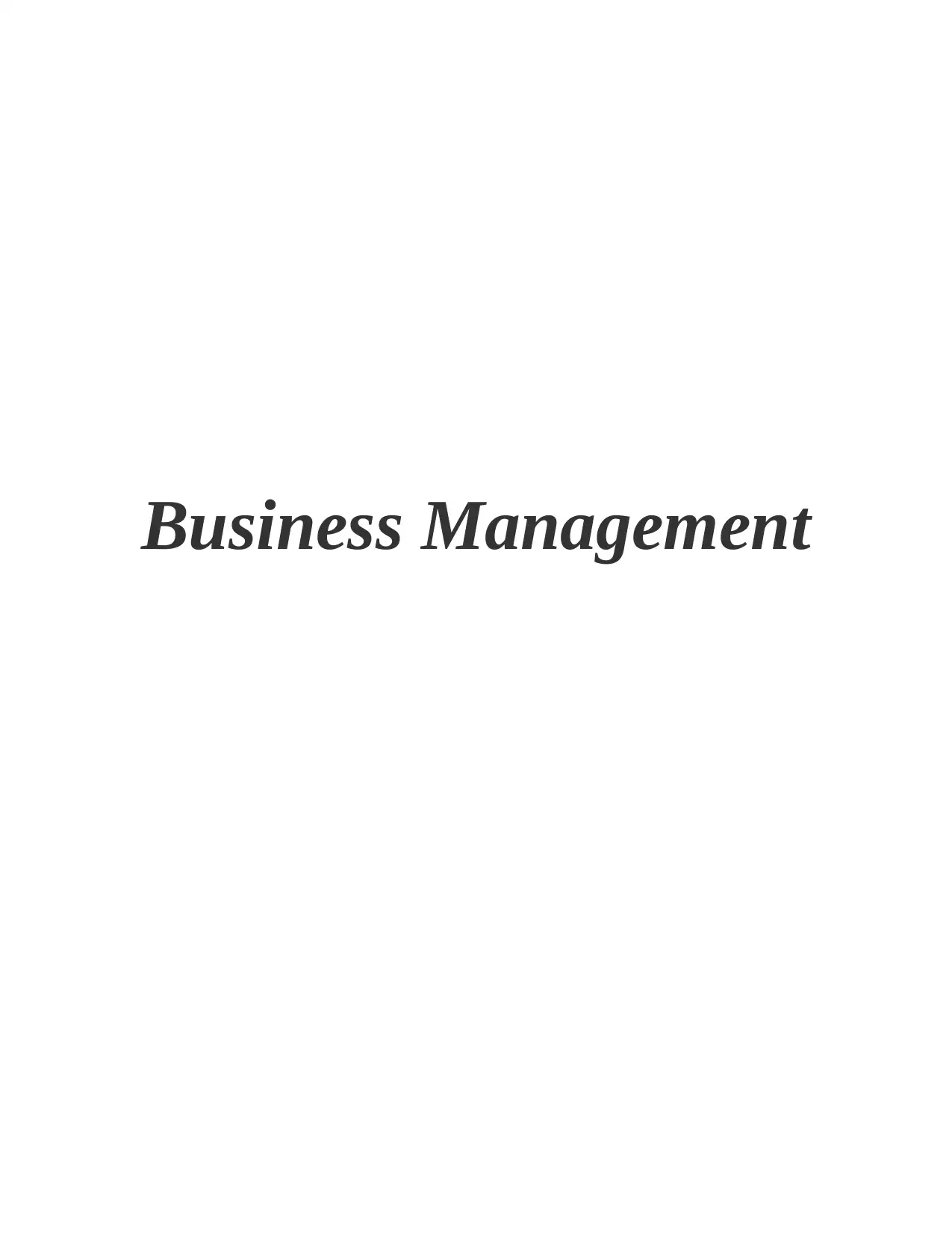
Business Management
Secure Best Marks with AI Grader
Need help grading? Try our AI Grader for instant feedback on your assignments.
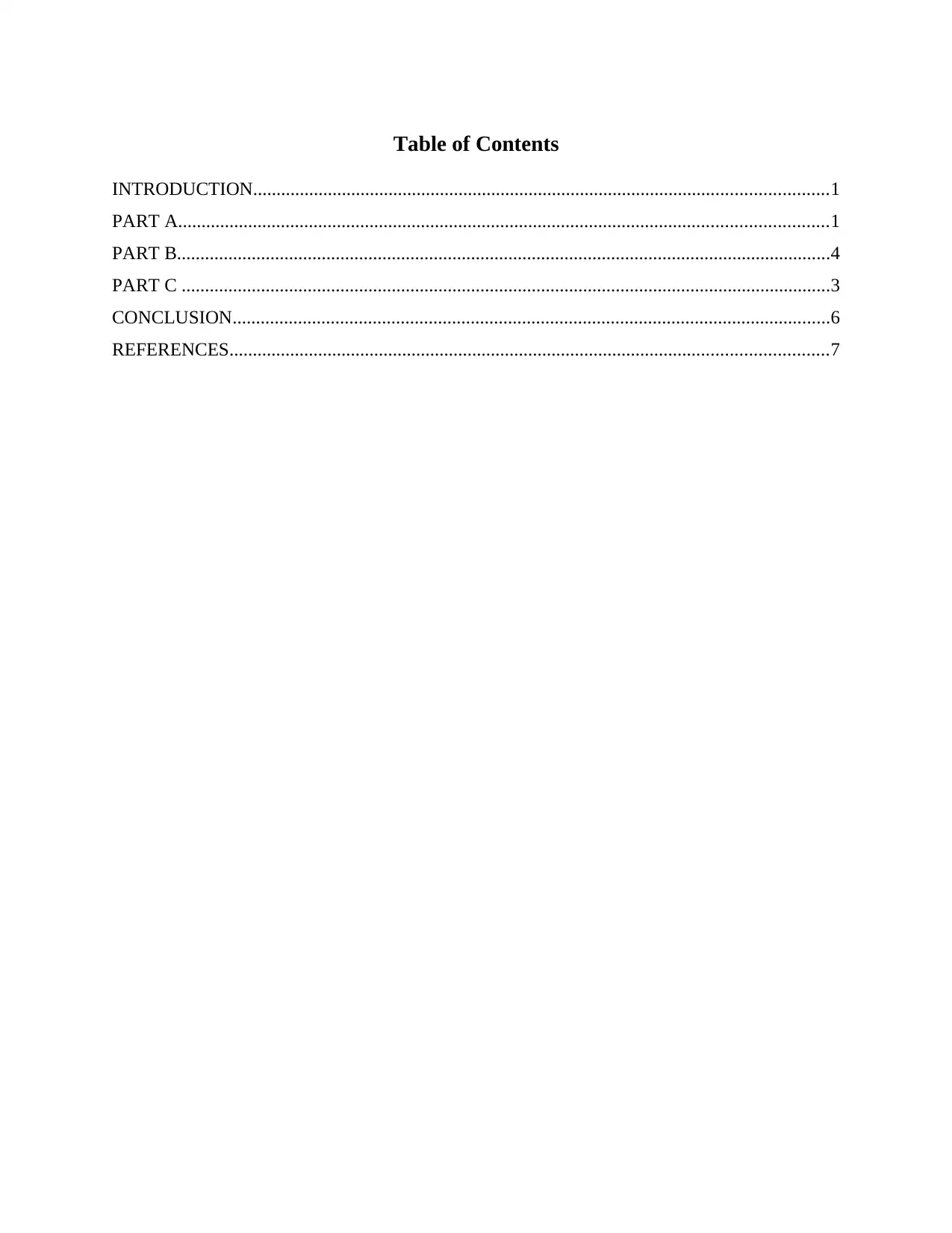
Table of Contents
INTRODUCTION...........................................................................................................................1
PART A...........................................................................................................................................1
PART B............................................................................................................................................4
PART C ...........................................................................................................................................3
CONCLUSION................................................................................................................................6
REFERENCES................................................................................................................................7
INTRODUCTION...........................................................................................................................1
PART A...........................................................................................................................................1
PART B............................................................................................................................................4
PART C ...........................................................................................................................................3
CONCLUSION................................................................................................................................6
REFERENCES................................................................................................................................7
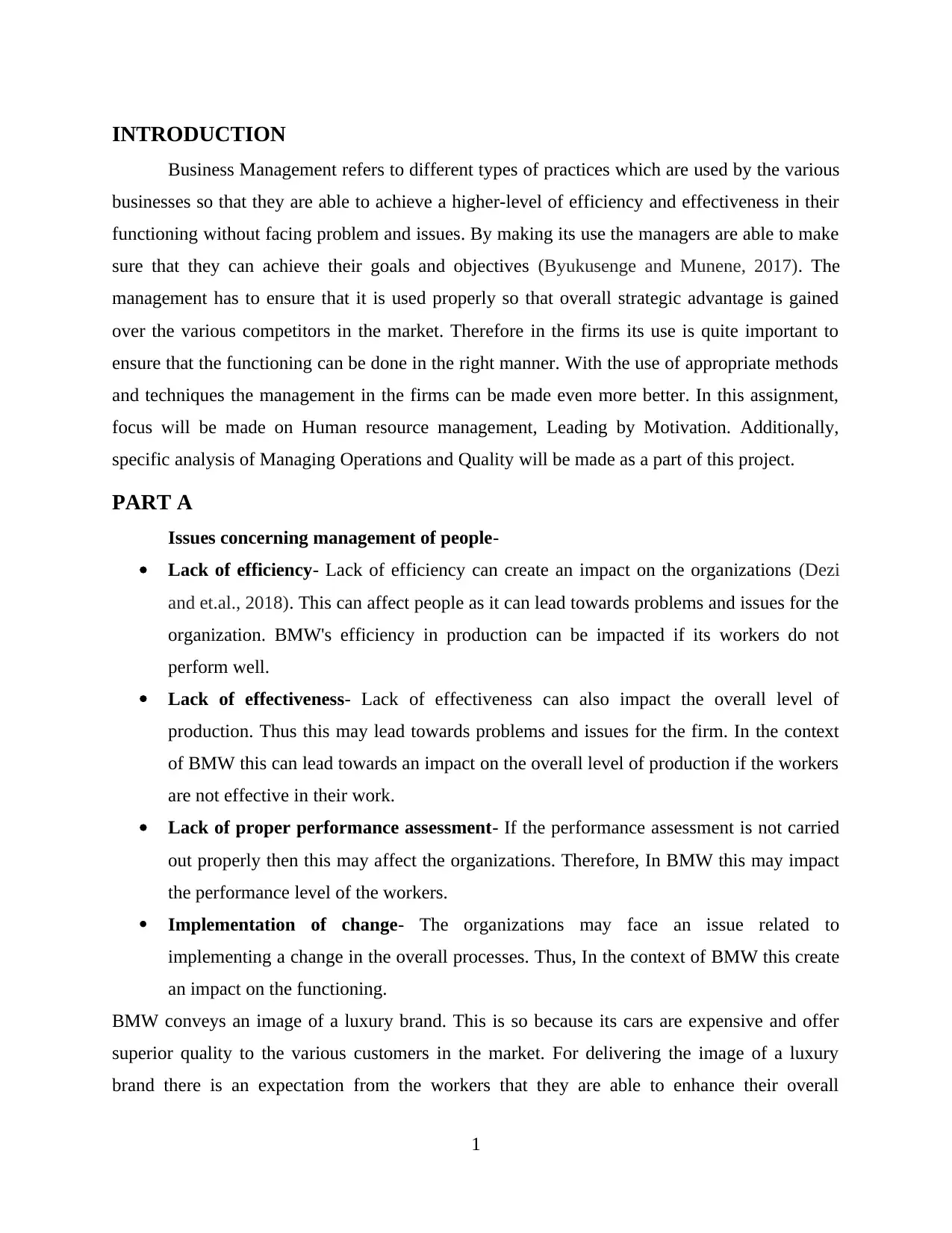
INTRODUCTION
Business Management refers to different types of practices which are used by the various
businesses so that they are able to achieve a higher-level of efficiency and effectiveness in their
functioning without facing problem and issues. By making its use the managers are able to make
sure that they can achieve their goals and objectives (Byukusenge and Munene, 2017). The
management has to ensure that it is used properly so that overall strategic advantage is gained
over the various competitors in the market. Therefore in the firms its use is quite important to
ensure that the functioning can be done in the right manner. With the use of appropriate methods
and techniques the management in the firms can be made even more better. In this assignment,
focus will be made on Human resource management, Leading by Motivation. Additionally,
specific analysis of Managing Operations and Quality will be made as a part of this project.
PART A
Issues concerning management of people-
Lack of efficiency- Lack of efficiency can create an impact on the organizations (Dezi
and et.al., 2018). This can affect people as it can lead towards problems and issues for the
organization. BMW's efficiency in production can be impacted if its workers do not
perform well.
Lack of effectiveness- Lack of effectiveness can also impact the overall level of
production. Thus this may lead towards problems and issues for the firm. In the context
of BMW this can lead towards an impact on the overall level of production if the workers
are not effective in their work.
Lack of proper performance assessment- If the performance assessment is not carried
out properly then this may affect the organizations. Therefore, In BMW this may impact
the performance level of the workers.
Implementation of change- The organizations may face an issue related to
implementing a change in the overall processes. Thus, In the context of BMW this create
an impact on the functioning.
BMW conveys an image of a luxury brand. This is so because its cars are expensive and offer
superior quality to the various customers in the market. For delivering the image of a luxury
brand there is an expectation from the workers that they are able to enhance their overall
1
Business Management refers to different types of practices which are used by the various
businesses so that they are able to achieve a higher-level of efficiency and effectiveness in their
functioning without facing problem and issues. By making its use the managers are able to make
sure that they can achieve their goals and objectives (Byukusenge and Munene, 2017). The
management has to ensure that it is used properly so that overall strategic advantage is gained
over the various competitors in the market. Therefore in the firms its use is quite important to
ensure that the functioning can be done in the right manner. With the use of appropriate methods
and techniques the management in the firms can be made even more better. In this assignment,
focus will be made on Human resource management, Leading by Motivation. Additionally,
specific analysis of Managing Operations and Quality will be made as a part of this project.
PART A
Issues concerning management of people-
Lack of efficiency- Lack of efficiency can create an impact on the organizations (Dezi
and et.al., 2018). This can affect people as it can lead towards problems and issues for the
organization. BMW's efficiency in production can be impacted if its workers do not
perform well.
Lack of effectiveness- Lack of effectiveness can also impact the overall level of
production. Thus this may lead towards problems and issues for the firm. In the context
of BMW this can lead towards an impact on the overall level of production if the workers
are not effective in their work.
Lack of proper performance assessment- If the performance assessment is not carried
out properly then this may affect the organizations. Therefore, In BMW this may impact
the performance level of the workers.
Implementation of change- The organizations may face an issue related to
implementing a change in the overall processes. Thus, In the context of BMW this create
an impact on the functioning.
BMW conveys an image of a luxury brand. This is so because its cars are expensive and offer
superior quality to the various customers in the market. For delivering the image of a luxury
brand there is an expectation from the workers that they are able to enhance their overall
1
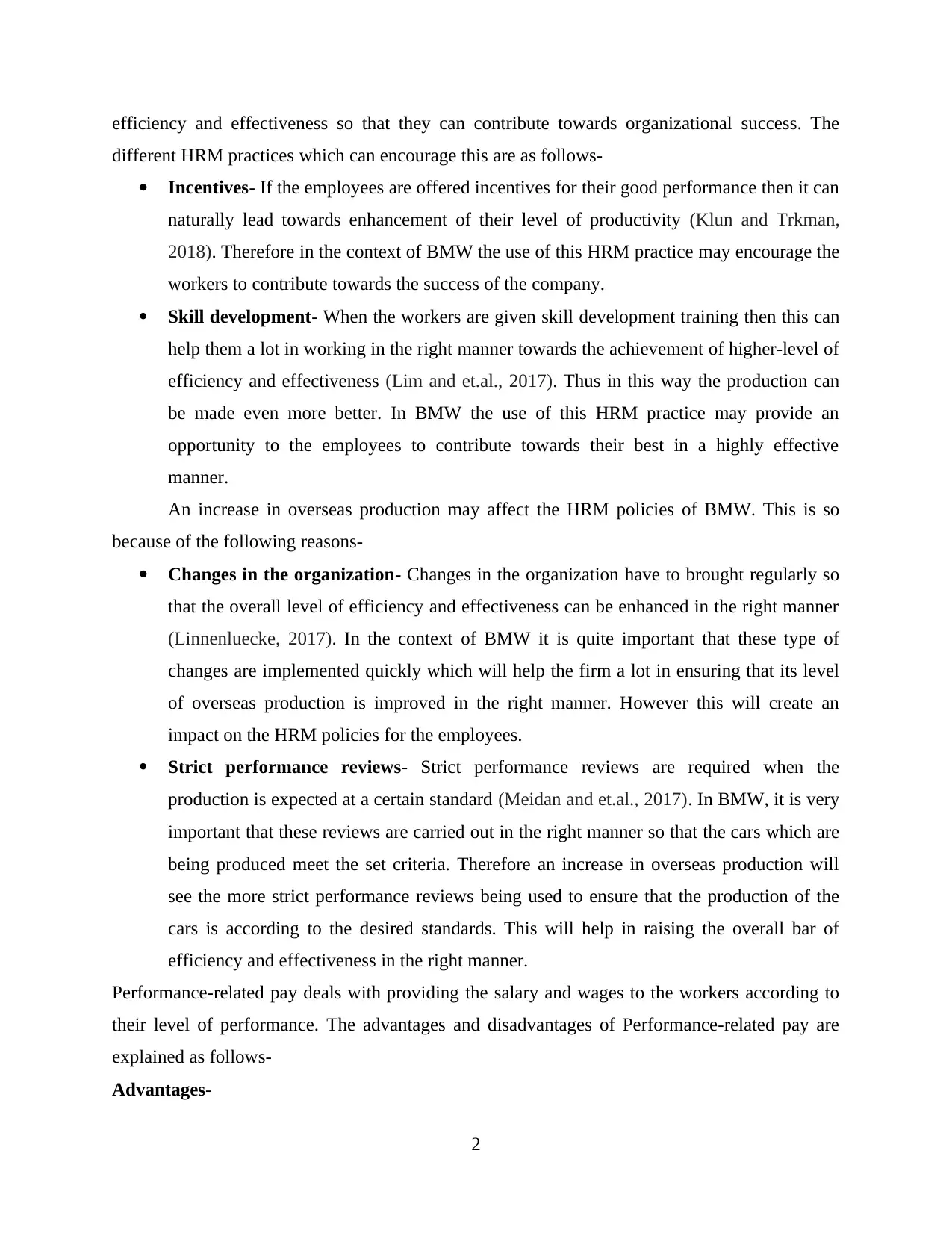
efficiency and effectiveness so that they can contribute towards organizational success. The
different HRM practices which can encourage this are as follows-
Incentives- If the employees are offered incentives for their good performance then it can
naturally lead towards enhancement of their level of productivity (Klun and Trkman,
2018). Therefore in the context of BMW the use of this HRM practice may encourage the
workers to contribute towards the success of the company.
Skill development- When the workers are given skill development training then this can
help them a lot in working in the right manner towards the achievement of higher-level of
efficiency and effectiveness (Lim and et.al., 2017). Thus in this way the production can
be made even more better. In BMW the use of this HRM practice may provide an
opportunity to the employees to contribute towards their best in a highly effective
manner.
An increase in overseas production may affect the HRM policies of BMW. This is so
because of the following reasons-
Changes in the organization- Changes in the organization have to brought regularly so
that the overall level of efficiency and effectiveness can be enhanced in the right manner
(Linnenluecke, 2017). In the context of BMW it is quite important that these type of
changes are implemented quickly which will help the firm a lot in ensuring that its level
of overseas production is improved in the right manner. However this will create an
impact on the HRM policies for the employees.
Strict performance reviews- Strict performance reviews are required when the
production is expected at a certain standard (Meidan and et.al., 2017). In BMW, it is very
important that these reviews are carried out in the right manner so that the cars which are
being produced meet the set criteria. Therefore an increase in overseas production will
see the more strict performance reviews being used to ensure that the production of the
cars is according to the desired standards. This will help in raising the overall bar of
efficiency and effectiveness in the right manner.
Performance-related pay deals with providing the salary and wages to the workers according to
their level of performance. The advantages and disadvantages of Performance-related pay are
explained as follows-
Advantages-
2
different HRM practices which can encourage this are as follows-
Incentives- If the employees are offered incentives for their good performance then it can
naturally lead towards enhancement of their level of productivity (Klun and Trkman,
2018). Therefore in the context of BMW the use of this HRM practice may encourage the
workers to contribute towards the success of the company.
Skill development- When the workers are given skill development training then this can
help them a lot in working in the right manner towards the achievement of higher-level of
efficiency and effectiveness (Lim and et.al., 2017). Thus in this way the production can
be made even more better. In BMW the use of this HRM practice may provide an
opportunity to the employees to contribute towards their best in a highly effective
manner.
An increase in overseas production may affect the HRM policies of BMW. This is so
because of the following reasons-
Changes in the organization- Changes in the organization have to brought regularly so
that the overall level of efficiency and effectiveness can be enhanced in the right manner
(Linnenluecke, 2017). In the context of BMW it is quite important that these type of
changes are implemented quickly which will help the firm a lot in ensuring that its level
of overseas production is improved in the right manner. However this will create an
impact on the HRM policies for the employees.
Strict performance reviews- Strict performance reviews are required when the
production is expected at a certain standard (Meidan and et.al., 2017). In BMW, it is very
important that these reviews are carried out in the right manner so that the cars which are
being produced meet the set criteria. Therefore an increase in overseas production will
see the more strict performance reviews being used to ensure that the production of the
cars is according to the desired standards. This will help in raising the overall bar of
efficiency and effectiveness in the right manner.
Performance-related pay deals with providing the salary and wages to the workers according to
their level of performance. The advantages and disadvantages of Performance-related pay are
explained as follows-
Advantages-
2
Secure Best Marks with AI Grader
Need help grading? Try our AI Grader for instant feedback on your assignments.
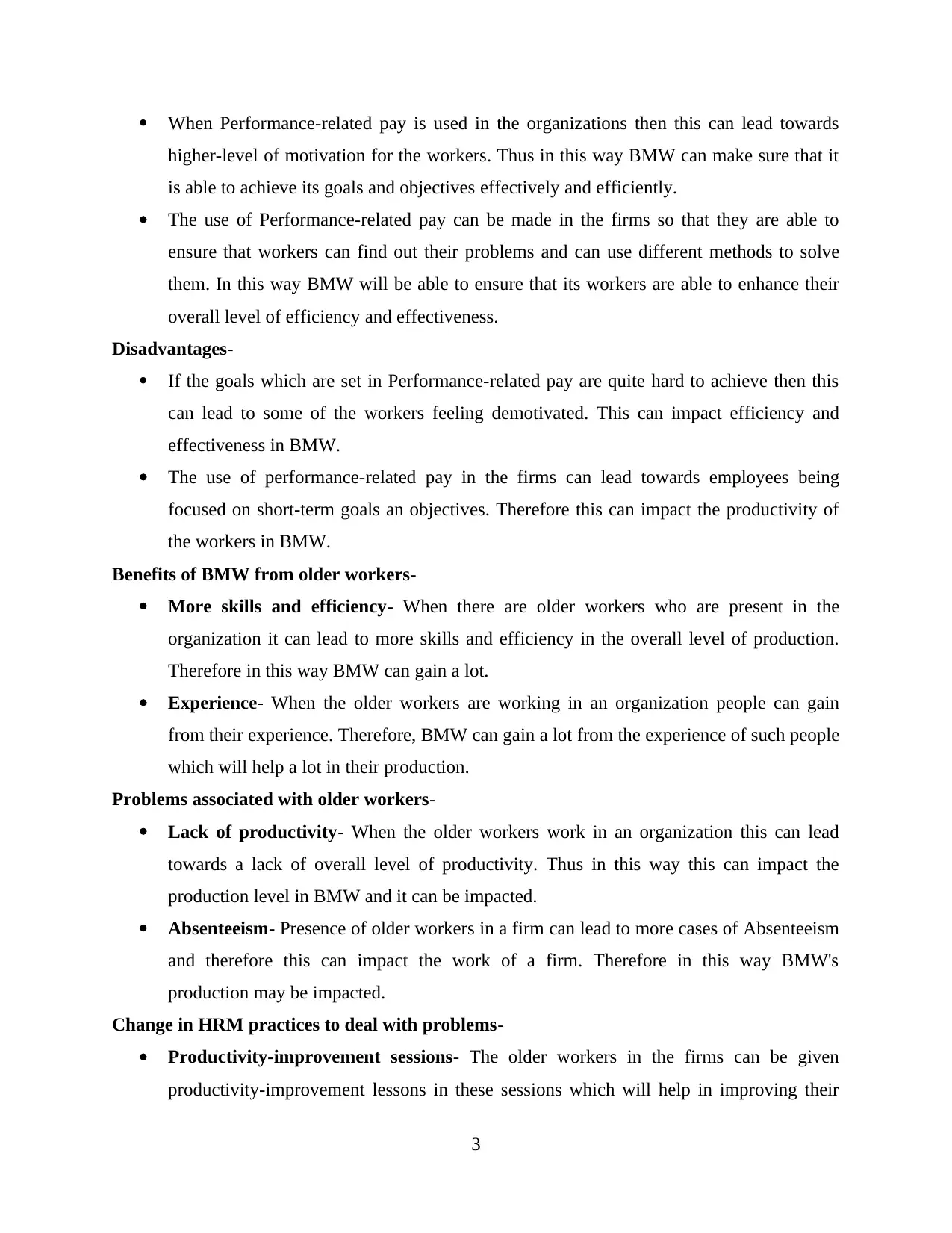
When Performance-related pay is used in the organizations then this can lead towards
higher-level of motivation for the workers. Thus in this way BMW can make sure that it
is able to achieve its goals and objectives effectively and efficiently.
The use of Performance-related pay can be made in the firms so that they are able to
ensure that workers can find out their problems and can use different methods to solve
them. In this way BMW will be able to ensure that its workers are able to enhance their
overall level of efficiency and effectiveness.
Disadvantages-
If the goals which are set in Performance-related pay are quite hard to achieve then this
can lead to some of the workers feeling demotivated. This can impact efficiency and
effectiveness in BMW.
The use of performance-related pay in the firms can lead towards employees being
focused on short-term goals an objectives. Therefore this can impact the productivity of
the workers in BMW.
Benefits of BMW from older workers-
More skills and efficiency- When there are older workers who are present in the
organization it can lead to more skills and efficiency in the overall level of production.
Therefore in this way BMW can gain a lot.
Experience- When the older workers are working in an organization people can gain
from their experience. Therefore, BMW can gain a lot from the experience of such people
which will help a lot in their production.
Problems associated with older workers-
Lack of productivity- When the older workers work in an organization this can lead
towards a lack of overall level of productivity. Thus in this way this can impact the
production level in BMW and it can be impacted.
Absenteeism- Presence of older workers in a firm can lead to more cases of Absenteeism
and therefore this can impact the work of a firm. Therefore in this way BMW's
production may be impacted.
Change in HRM practices to deal with problems-
Productivity-improvement sessions- The older workers in the firms can be given
productivity-improvement lessons in these sessions which will help in improving their
3
higher-level of motivation for the workers. Thus in this way BMW can make sure that it
is able to achieve its goals and objectives effectively and efficiently.
The use of Performance-related pay can be made in the firms so that they are able to
ensure that workers can find out their problems and can use different methods to solve
them. In this way BMW will be able to ensure that its workers are able to enhance their
overall level of efficiency and effectiveness.
Disadvantages-
If the goals which are set in Performance-related pay are quite hard to achieve then this
can lead to some of the workers feeling demotivated. This can impact efficiency and
effectiveness in BMW.
The use of performance-related pay in the firms can lead towards employees being
focused on short-term goals an objectives. Therefore this can impact the productivity of
the workers in BMW.
Benefits of BMW from older workers-
More skills and efficiency- When there are older workers who are present in the
organization it can lead to more skills and efficiency in the overall level of production.
Therefore in this way BMW can gain a lot.
Experience- When the older workers are working in an organization people can gain
from their experience. Therefore, BMW can gain a lot from the experience of such people
which will help a lot in their production.
Problems associated with older workers-
Lack of productivity- When the older workers work in an organization this can lead
towards a lack of overall level of productivity. Thus in this way this can impact the
production level in BMW and it can be impacted.
Absenteeism- Presence of older workers in a firm can lead to more cases of Absenteeism
and therefore this can impact the work of a firm. Therefore in this way BMW's
production may be impacted.
Change in HRM practices to deal with problems-
Productivity-improvement sessions- The older workers in the firms can be given
productivity-improvement lessons in these sessions which will help in improving their
3
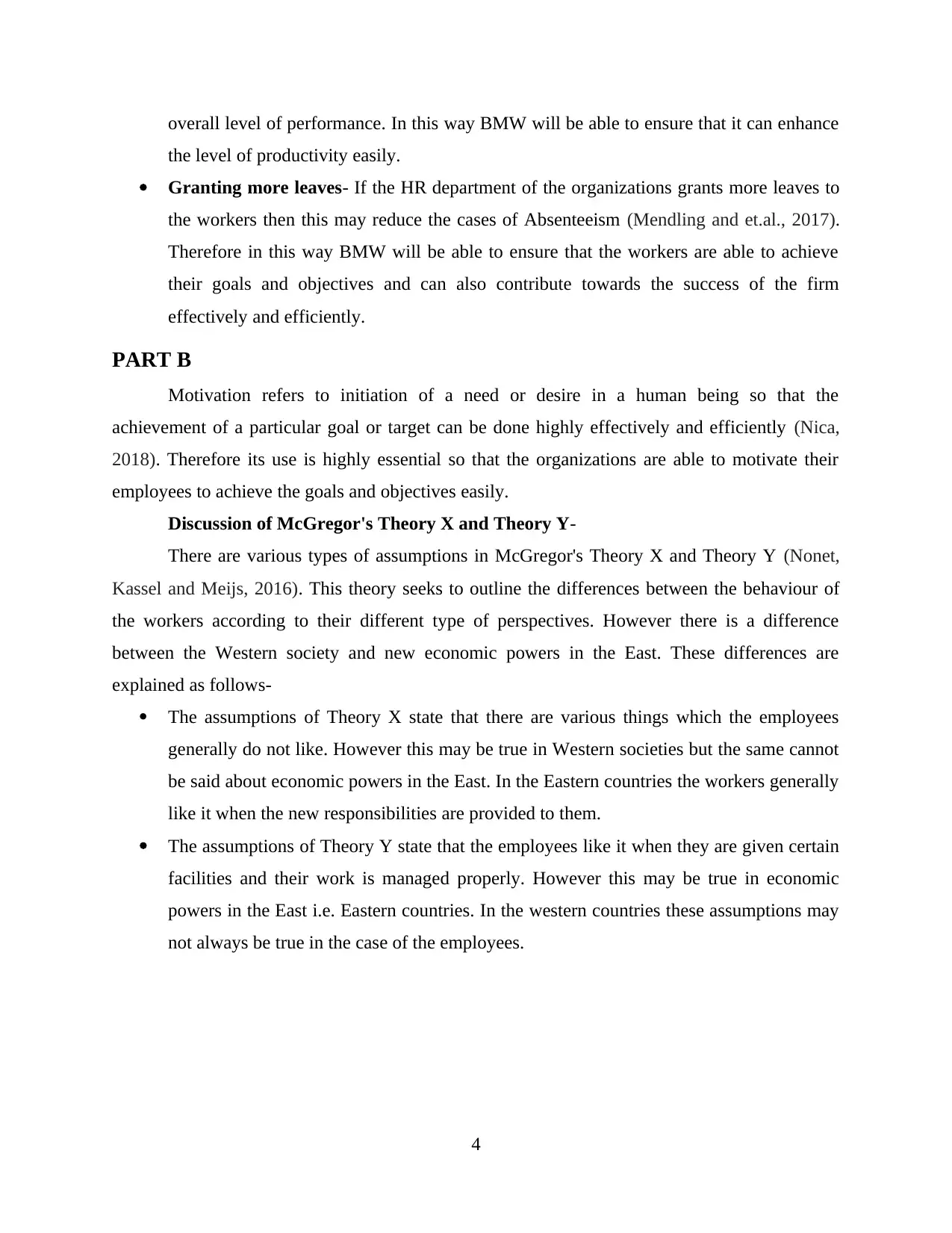
overall level of performance. In this way BMW will be able to ensure that it can enhance
the level of productivity easily.
Granting more leaves- If the HR department of the organizations grants more leaves to
the workers then this may reduce the cases of Absenteeism (Mendling and et.al., 2017).
Therefore in this way BMW will be able to ensure that the workers are able to achieve
their goals and objectives and can also contribute towards the success of the firm
effectively and efficiently.
PART B
Motivation refers to initiation of a need or desire in a human being so that the
achievement of a particular goal or target can be done highly effectively and efficiently (Nica,
2018). Therefore its use is highly essential so that the organizations are able to motivate their
employees to achieve the goals and objectives easily.
Discussion of McGregor's Theory X and Theory Y-
There are various types of assumptions in McGregor's Theory X and Theory Y (Nonet,
Kassel and Meijs, 2016). This theory seeks to outline the differences between the behaviour of
the workers according to their different type of perspectives. However there is a difference
between the Western society and new economic powers in the East. These differences are
explained as follows-
The assumptions of Theory X state that there are various things which the employees
generally do not like. However this may be true in Western societies but the same cannot
be said about economic powers in the East. In the Eastern countries the workers generally
like it when the new responsibilities are provided to them.
The assumptions of Theory Y state that the employees like it when they are given certain
facilities and their work is managed properly. However this may be true in economic
powers in the East i.e. Eastern countries. In the western countries these assumptions may
not always be true in the case of the employees.
4
the level of productivity easily.
Granting more leaves- If the HR department of the organizations grants more leaves to
the workers then this may reduce the cases of Absenteeism (Mendling and et.al., 2017).
Therefore in this way BMW will be able to ensure that the workers are able to achieve
their goals and objectives and can also contribute towards the success of the firm
effectively and efficiently.
PART B
Motivation refers to initiation of a need or desire in a human being so that the
achievement of a particular goal or target can be done highly effectively and efficiently (Nica,
2018). Therefore its use is highly essential so that the organizations are able to motivate their
employees to achieve the goals and objectives easily.
Discussion of McGregor's Theory X and Theory Y-
There are various types of assumptions in McGregor's Theory X and Theory Y (Nonet,
Kassel and Meijs, 2016). This theory seeks to outline the differences between the behaviour of
the workers according to their different type of perspectives. However there is a difference
between the Western society and new economic powers in the East. These differences are
explained as follows-
The assumptions of Theory X state that there are various things which the employees
generally do not like. However this may be true in Western societies but the same cannot
be said about economic powers in the East. In the Eastern countries the workers generally
like it when the new responsibilities are provided to them.
The assumptions of Theory Y state that the employees like it when they are given certain
facilities and their work is managed properly. However this may be true in economic
powers in the East i.e. Eastern countries. In the western countries these assumptions may
not always be true in the case of the employees.
4
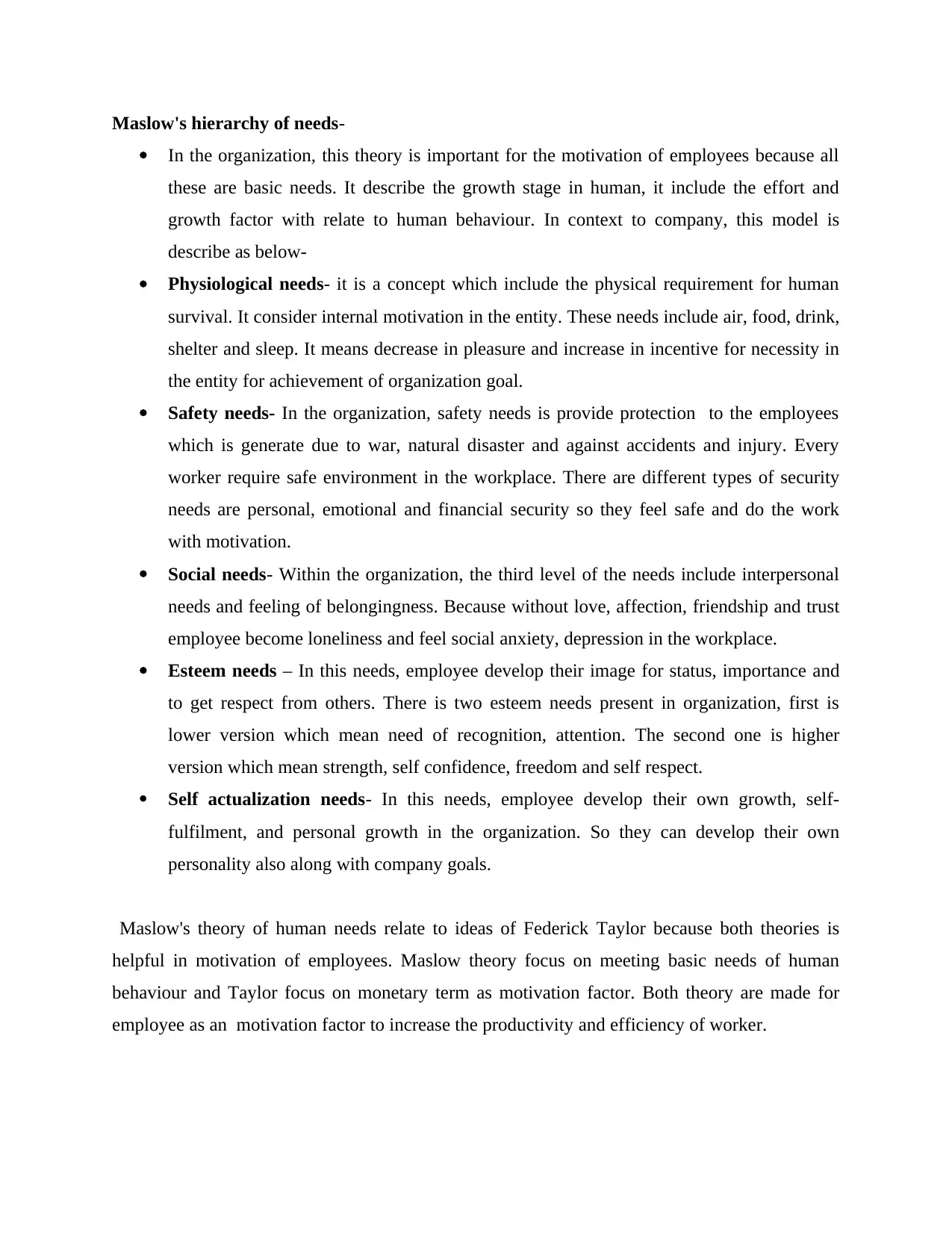
Maslow's hierarchy of needs-
In the organization, this theory is important for the motivation of employees because all
these are basic needs. It describe the growth stage in human, it include the effort and
growth factor with relate to human behaviour. In context to company, this model is
describe as below-
Physiological needs- it is a concept which include the physical requirement for human
survival. It consider internal motivation in the entity. These needs include air, food, drink,
shelter and sleep. It means decrease in pleasure and increase in incentive for necessity in
the entity for achievement of organization goal.
Safety needs- In the organization, safety needs is provide protection to the employees
which is generate due to war, natural disaster and against accidents and injury. Every
worker require safe environment in the workplace. There are different types of security
needs are personal, emotional and financial security so they feel safe and do the work
with motivation.
Social needs- Within the organization, the third level of the needs include interpersonal
needs and feeling of belongingness. Because without love, affection, friendship and trust
employee become loneliness and feel social anxiety, depression in the workplace.
Esteem needs – In this needs, employee develop their image for status, importance and
to get respect from others. There is two esteem needs present in organization, first is
lower version which mean need of recognition, attention. The second one is higher
version which mean strength, self confidence, freedom and self respect.
Self actualization needs- In this needs, employee develop their own growth, self-
fulfilment, and personal growth in the organization. So they can develop their own
personality also along with company goals.
Maslow's theory of human needs relate to ideas of Federick Taylor because both theories is
helpful in motivation of employees. Maslow theory focus on meeting basic needs of human
behaviour and Taylor focus on monetary term as motivation factor. Both theory are made for
employee as an motivation factor to increase the productivity and efficiency of worker.
In the organization, this theory is important for the motivation of employees because all
these are basic needs. It describe the growth stage in human, it include the effort and
growth factor with relate to human behaviour. In context to company, this model is
describe as below-
Physiological needs- it is a concept which include the physical requirement for human
survival. It consider internal motivation in the entity. These needs include air, food, drink,
shelter and sleep. It means decrease in pleasure and increase in incentive for necessity in
the entity for achievement of organization goal.
Safety needs- In the organization, safety needs is provide protection to the employees
which is generate due to war, natural disaster and against accidents and injury. Every
worker require safe environment in the workplace. There are different types of security
needs are personal, emotional and financial security so they feel safe and do the work
with motivation.
Social needs- Within the organization, the third level of the needs include interpersonal
needs and feeling of belongingness. Because without love, affection, friendship and trust
employee become loneliness and feel social anxiety, depression in the workplace.
Esteem needs – In this needs, employee develop their image for status, importance and
to get respect from others. There is two esteem needs present in organization, first is
lower version which mean need of recognition, attention. The second one is higher
version which mean strength, self confidence, freedom and self respect.
Self actualization needs- In this needs, employee develop their own growth, self-
fulfilment, and personal growth in the organization. So they can develop their own
personality also along with company goals.
Maslow's theory of human needs relate to ideas of Federick Taylor because both theories is
helpful in motivation of employees. Maslow theory focus on meeting basic needs of human
behaviour and Taylor focus on monetary term as motivation factor. Both theory are made for
employee as an motivation factor to increase the productivity and efficiency of worker.
Paraphrase This Document
Need a fresh take? Get an instant paraphrase of this document with our AI Paraphraser
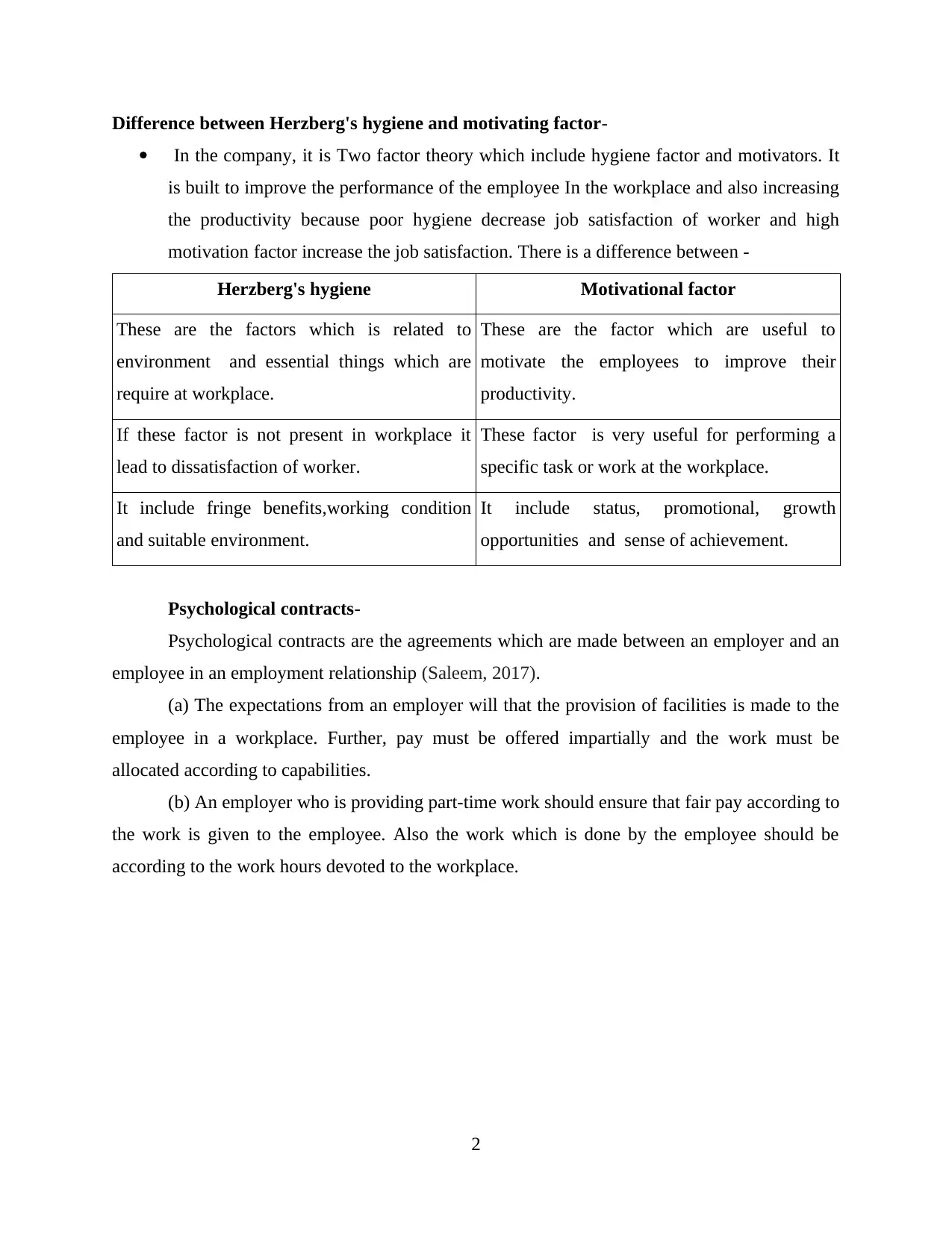
Difference between Herzberg's hygiene and motivating factor-
In the company, it is Two factor theory which include hygiene factor and motivators. It
is built to improve the performance of the employee In the workplace and also increasing
the productivity because poor hygiene decrease job satisfaction of worker and high
motivation factor increase the job satisfaction. There is a difference between -
Herzberg's hygiene Motivational factor
These are the factors which is related to
environment and essential things which are
require at workplace.
These are the factor which are useful to
motivate the employees to improve their
productivity.
If these factor is not present in workplace it
lead to dissatisfaction of worker.
These factor is very useful for performing a
specific task or work at the workplace.
It include fringe benefits,working condition
and suitable environment.
It include status, promotional, growth
opportunities and sense of achievement.
Psychological contracts-
Psychological contracts are the agreements which are made between an employer and an
employee in an employment relationship (Saleem, 2017).
(a) The expectations from an employer will that the provision of facilities is made to the
employee in a workplace. Further, pay must be offered impartially and the work must be
allocated according to capabilities.
(b) An employer who is providing part-time work should ensure that fair pay according to
the work is given to the employee. Also the work which is done by the employee should be
according to the work hours devoted to the workplace.
2
In the company, it is Two factor theory which include hygiene factor and motivators. It
is built to improve the performance of the employee In the workplace and also increasing
the productivity because poor hygiene decrease job satisfaction of worker and high
motivation factor increase the job satisfaction. There is a difference between -
Herzberg's hygiene Motivational factor
These are the factors which is related to
environment and essential things which are
require at workplace.
These are the factor which are useful to
motivate the employees to improve their
productivity.
If these factor is not present in workplace it
lead to dissatisfaction of worker.
These factor is very useful for performing a
specific task or work at the workplace.
It include fringe benefits,working condition
and suitable environment.
It include status, promotional, growth
opportunities and sense of achievement.
Psychological contracts-
Psychological contracts are the agreements which are made between an employer and an
employee in an employment relationship (Saleem, 2017).
(a) The expectations from an employer will that the provision of facilities is made to the
employee in a workplace. Further, pay must be offered impartially and the work must be
allocated according to capabilities.
(b) An employer who is providing part-time work should ensure that fair pay according to
the work is given to the employee. Also the work which is done by the employee should be
according to the work hours devoted to the workplace.
2
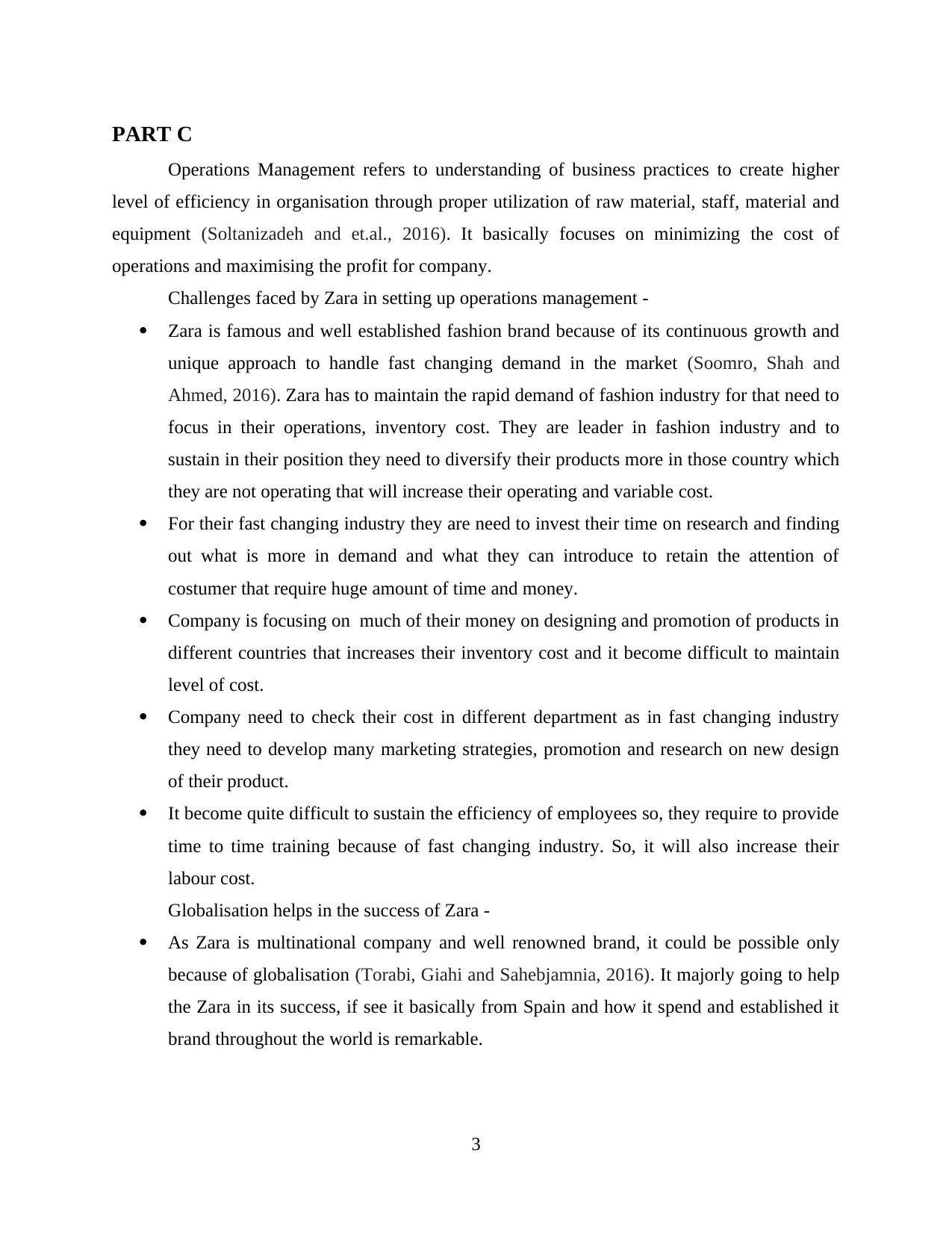
PART C
Operations Management refers to understanding of business practices to create higher
level of efficiency in organisation through proper utilization of raw material, staff, material and
equipment (Soltanizadeh and et.al., 2016). It basically focuses on minimizing the cost of
operations and maximising the profit for company.
Challenges faced by Zara in setting up operations management -
Zara is famous and well established fashion brand because of its continuous growth and
unique approach to handle fast changing demand in the market (Soomro, Shah and
Ahmed, 2016). Zara has to maintain the rapid demand of fashion industry for that need to
focus in their operations, inventory cost. They are leader in fashion industry and to
sustain in their position they need to diversify their products more in those country which
they are not operating that will increase their operating and variable cost.
For their fast changing industry they are need to invest their time on research and finding
out what is more in demand and what they can introduce to retain the attention of
costumer that require huge amount of time and money.
Company is focusing on much of their money on designing and promotion of products in
different countries that increases their inventory cost and it become difficult to maintain
level of cost.
Company need to check their cost in different department as in fast changing industry
they need to develop many marketing strategies, promotion and research on new design
of their product.
It become quite difficult to sustain the efficiency of employees so, they require to provide
time to time training because of fast changing industry. So, it will also increase their
labour cost.
Globalisation helps in the success of Zara -
As Zara is multinational company and well renowned brand, it could be possible only
because of globalisation (Torabi, Giahi and Sahebjamnia, 2016). It majorly going to help
the Zara in its success, if see it basically from Spain and how it spend and established it
brand throughout the world is remarkable.
3
Operations Management refers to understanding of business practices to create higher
level of efficiency in organisation through proper utilization of raw material, staff, material and
equipment (Soltanizadeh and et.al., 2016). It basically focuses on minimizing the cost of
operations and maximising the profit for company.
Challenges faced by Zara in setting up operations management -
Zara is famous and well established fashion brand because of its continuous growth and
unique approach to handle fast changing demand in the market (Soomro, Shah and
Ahmed, 2016). Zara has to maintain the rapid demand of fashion industry for that need to
focus in their operations, inventory cost. They are leader in fashion industry and to
sustain in their position they need to diversify their products more in those country which
they are not operating that will increase their operating and variable cost.
For their fast changing industry they are need to invest their time on research and finding
out what is more in demand and what they can introduce to retain the attention of
costumer that require huge amount of time and money.
Company is focusing on much of their money on designing and promotion of products in
different countries that increases their inventory cost and it become difficult to maintain
level of cost.
Company need to check their cost in different department as in fast changing industry
they need to develop many marketing strategies, promotion and research on new design
of their product.
It become quite difficult to sustain the efficiency of employees so, they require to provide
time to time training because of fast changing industry. So, it will also increase their
labour cost.
Globalisation helps in the success of Zara -
As Zara is multinational company and well renowned brand, it could be possible only
because of globalisation (Torabi, Giahi and Sahebjamnia, 2016). It majorly going to help
the Zara in its success, if see it basically from Spain and how it spend and established it
brand throughout the world is remarkable.
3
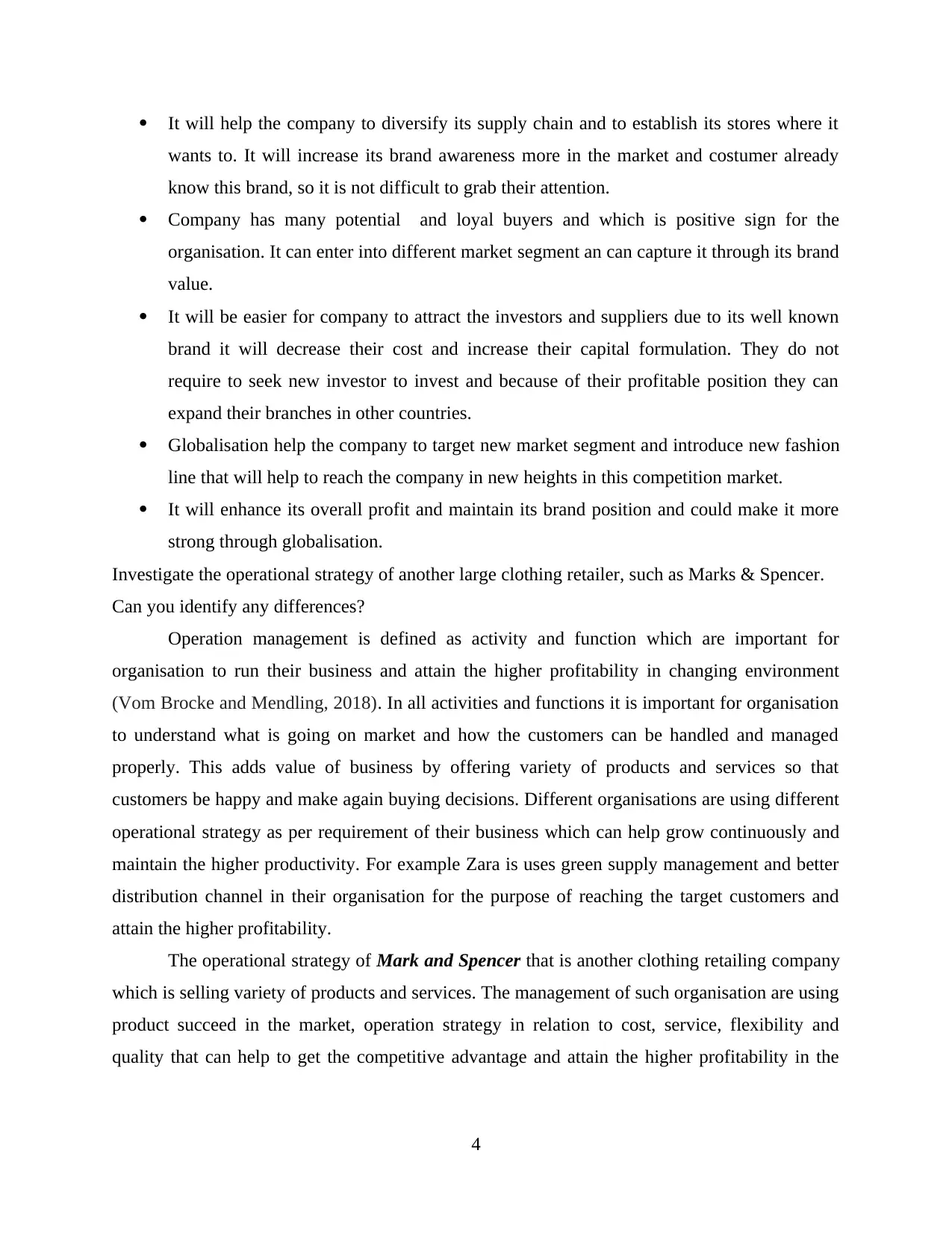
It will help the company to diversify its supply chain and to establish its stores where it
wants to. It will increase its brand awareness more in the market and costumer already
know this brand, so it is not difficult to grab their attention.
Company has many potential and loyal buyers and which is positive sign for the
organisation. It can enter into different market segment an can capture it through its brand
value.
It will be easier for company to attract the investors and suppliers due to its well known
brand it will decrease their cost and increase their capital formulation. They do not
require to seek new investor to invest and because of their profitable position they can
expand their branches in other countries.
Globalisation help the company to target new market segment and introduce new fashion
line that will help to reach the company in new heights in this competition market.
It will enhance its overall profit and maintain its brand position and could make it more
strong through globalisation.
Investigate the operational strategy of another large clothing retailer, such as Marks & Spencer.
Can you identify any differences?
Operation management is defined as activity and function which are important for
organisation to run their business and attain the higher profitability in changing environment
(Vom Brocke and Mendling, 2018). In all activities and functions it is important for organisation
to understand what is going on market and how the customers can be handled and managed
properly. This adds value of business by offering variety of products and services so that
customers be happy and make again buying decisions. Different organisations are using different
operational strategy as per requirement of their business which can help grow continuously and
maintain the higher productivity. For example Zara is uses green supply management and better
distribution channel in their organisation for the purpose of reaching the target customers and
attain the higher profitability.
The operational strategy of Mark and Spencer that is another clothing retailing company
which is selling variety of products and services. The management of such organisation are using
product succeed in the market, operation strategy in relation to cost, service, flexibility and
quality that can help to get the competitive advantage and attain the higher profitability in the
4
wants to. It will increase its brand awareness more in the market and costumer already
know this brand, so it is not difficult to grab their attention.
Company has many potential and loyal buyers and which is positive sign for the
organisation. It can enter into different market segment an can capture it through its brand
value.
It will be easier for company to attract the investors and suppliers due to its well known
brand it will decrease their cost and increase their capital formulation. They do not
require to seek new investor to invest and because of their profitable position they can
expand their branches in other countries.
Globalisation help the company to target new market segment and introduce new fashion
line that will help to reach the company in new heights in this competition market.
It will enhance its overall profit and maintain its brand position and could make it more
strong through globalisation.
Investigate the operational strategy of another large clothing retailer, such as Marks & Spencer.
Can you identify any differences?
Operation management is defined as activity and function which are important for
organisation to run their business and attain the higher profitability in changing environment
(Vom Brocke and Mendling, 2018). In all activities and functions it is important for organisation
to understand what is going on market and how the customers can be handled and managed
properly. This adds value of business by offering variety of products and services so that
customers be happy and make again buying decisions. Different organisations are using different
operational strategy as per requirement of their business which can help grow continuously and
maintain the higher productivity. For example Zara is uses green supply management and better
distribution channel in their organisation for the purpose of reaching the target customers and
attain the higher profitability.
The operational strategy of Mark and Spencer that is another clothing retailing company
which is selling variety of products and services. The management of such organisation are using
product succeed in the market, operation strategy in relation to cost, service, flexibility and
quality that can help to get the competitive advantage and attain the higher profitability in the
4
Secure Best Marks with AI Grader
Need help grading? Try our AI Grader for instant feedback on your assignments.
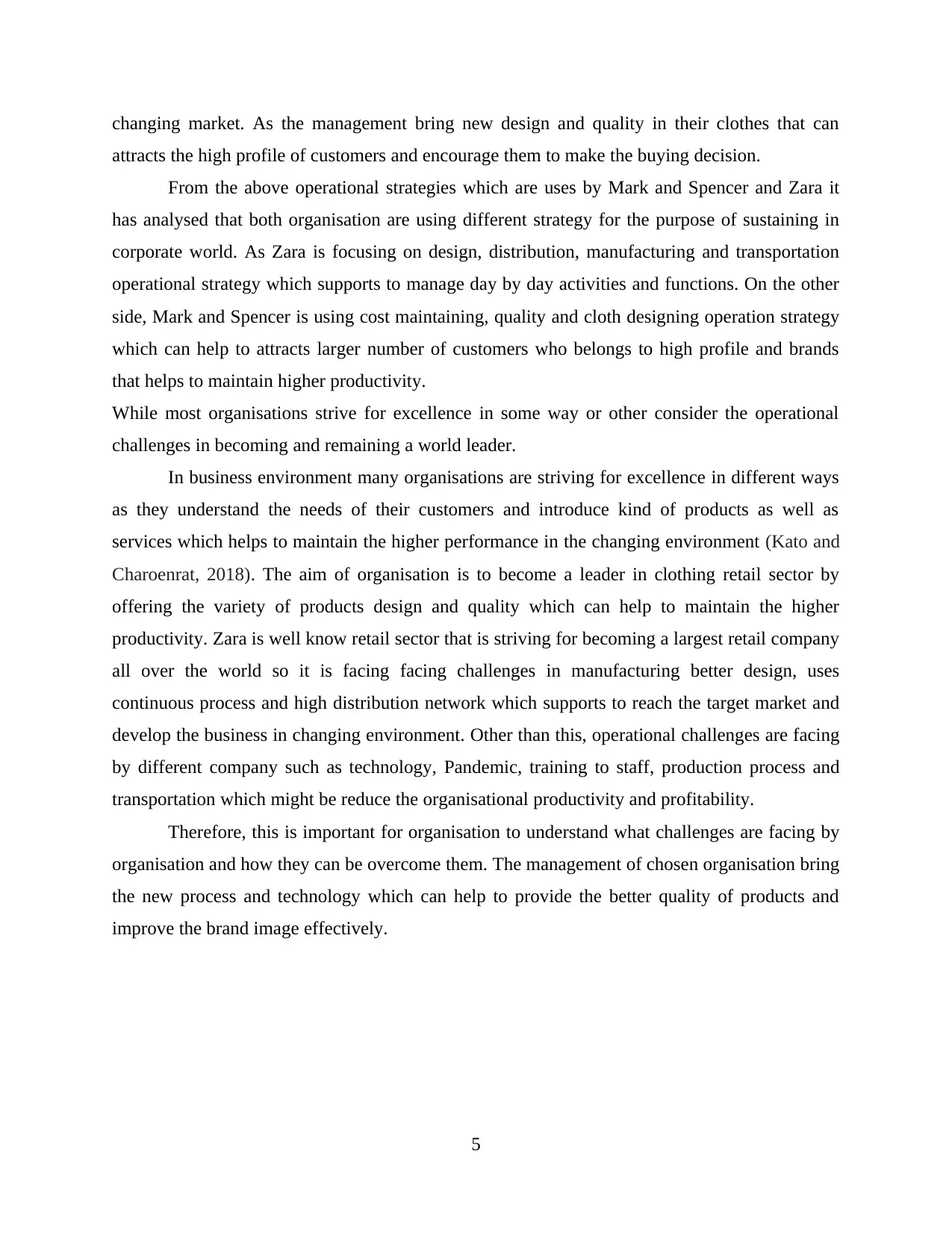
changing market. As the management bring new design and quality in their clothes that can
attracts the high profile of customers and encourage them to make the buying decision.
From the above operational strategies which are uses by Mark and Spencer and Zara it
has analysed that both organisation are using different strategy for the purpose of sustaining in
corporate world. As Zara is focusing on design, distribution, manufacturing and transportation
operational strategy which supports to manage day by day activities and functions. On the other
side, Mark and Spencer is using cost maintaining, quality and cloth designing operation strategy
which can help to attracts larger number of customers who belongs to high profile and brands
that helps to maintain higher productivity.
While most organisations strive for excellence in some way or other consider the operational
challenges in becoming and remaining a world leader.
In business environment many organisations are striving for excellence in different ways
as they understand the needs of their customers and introduce kind of products as well as
services which helps to maintain the higher performance in the changing environment (Kato and
Charoenrat, 2018). The aim of organisation is to become a leader in clothing retail sector by
offering the variety of products design and quality which can help to maintain the higher
productivity. Zara is well know retail sector that is striving for becoming a largest retail company
all over the world so it is facing facing challenges in manufacturing better design, uses
continuous process and high distribution network which supports to reach the target market and
develop the business in changing environment. Other than this, operational challenges are facing
by different company such as technology, Pandemic, training to staff, production process and
transportation which might be reduce the organisational productivity and profitability.
Therefore, this is important for organisation to understand what challenges are facing by
organisation and how they can be overcome them. The management of chosen organisation bring
the new process and technology which can help to provide the better quality of products and
improve the brand image effectively.
5
attracts the high profile of customers and encourage them to make the buying decision.
From the above operational strategies which are uses by Mark and Spencer and Zara it
has analysed that both organisation are using different strategy for the purpose of sustaining in
corporate world. As Zara is focusing on design, distribution, manufacturing and transportation
operational strategy which supports to manage day by day activities and functions. On the other
side, Mark and Spencer is using cost maintaining, quality and cloth designing operation strategy
which can help to attracts larger number of customers who belongs to high profile and brands
that helps to maintain higher productivity.
While most organisations strive for excellence in some way or other consider the operational
challenges in becoming and remaining a world leader.
In business environment many organisations are striving for excellence in different ways
as they understand the needs of their customers and introduce kind of products as well as
services which helps to maintain the higher performance in the changing environment (Kato and
Charoenrat, 2018). The aim of organisation is to become a leader in clothing retail sector by
offering the variety of products design and quality which can help to maintain the higher
productivity. Zara is well know retail sector that is striving for becoming a largest retail company
all over the world so it is facing facing challenges in manufacturing better design, uses
continuous process and high distribution network which supports to reach the target market and
develop the business in changing environment. Other than this, operational challenges are facing
by different company such as technology, Pandemic, training to staff, production process and
transportation which might be reduce the organisational productivity and profitability.
Therefore, this is important for organisation to understand what challenges are facing by
organisation and how they can be overcome them. The management of chosen organisation bring
the new process and technology which can help to provide the better quality of products and
improve the brand image effectively.
5
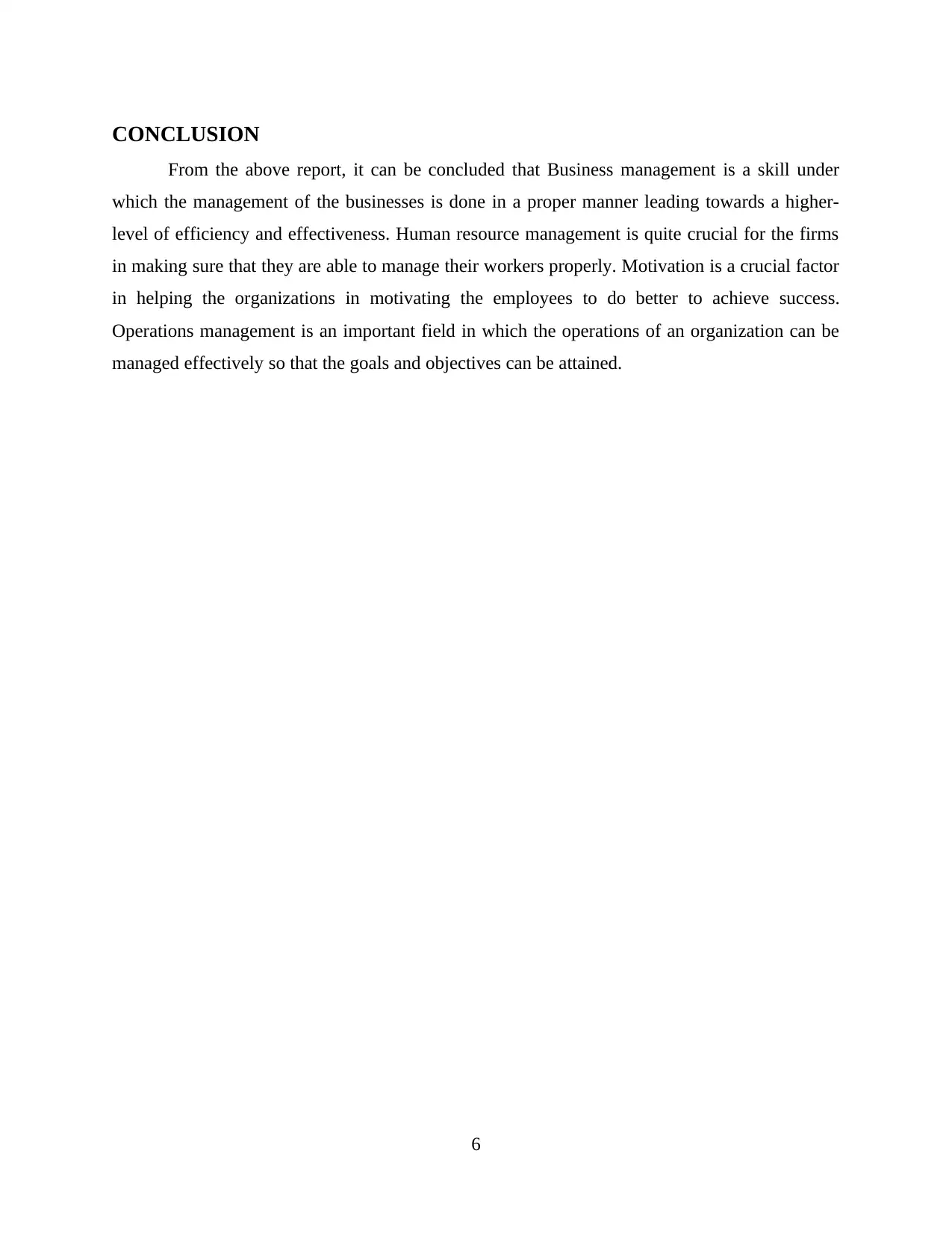
CONCLUSION
From the above report, it can be concluded that Business management is a skill under
which the management of the businesses is done in a proper manner leading towards a higher-
level of efficiency and effectiveness. Human resource management is quite crucial for the firms
in making sure that they are able to manage their workers properly. Motivation is a crucial factor
in helping the organizations in motivating the employees to do better to achieve success.
Operations management is an important field in which the operations of an organization can be
managed effectively so that the goals and objectives can be attained.
6
From the above report, it can be concluded that Business management is a skill under
which the management of the businesses is done in a proper manner leading towards a higher-
level of efficiency and effectiveness. Human resource management is quite crucial for the firms
in making sure that they are able to manage their workers properly. Motivation is a crucial factor
in helping the organizations in motivating the employees to do better to achieve success.
Operations management is an important field in which the operations of an organization can be
managed effectively so that the goals and objectives can be attained.
6
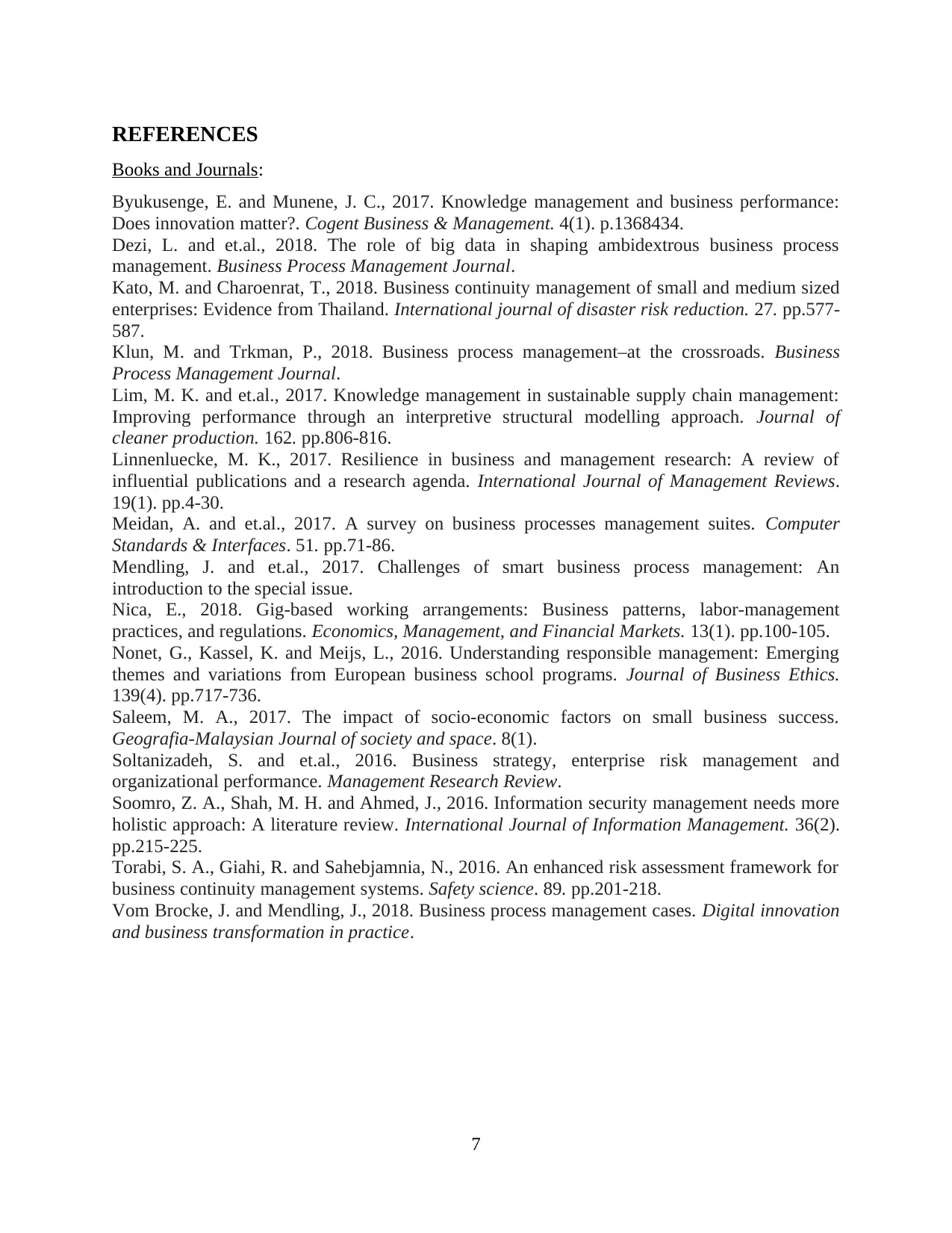
REFERENCES
Books and Journals:
Byukusenge, E. and Munene, J. C., 2017. Knowledge management and business performance:
Does innovation matter?. Cogent Business & Management. 4(1). p.1368434.
Dezi, L. and et.al., 2018. The role of big data in shaping ambidextrous business process
management. Business Process Management Journal.
Kato, M. and Charoenrat, T., 2018. Business continuity management of small and medium sized
enterprises: Evidence from Thailand. International journal of disaster risk reduction. 27. pp.577-
587.
Klun, M. and Trkman, P., 2018. Business process management–at the crossroads. Business
Process Management Journal.
Lim, M. K. and et.al., 2017. Knowledge management in sustainable supply chain management:
Improving performance through an interpretive structural modelling approach. Journal of
cleaner production. 162. pp.806-816.
Linnenluecke, M. K., 2017. Resilience in business and management research: A review of
influential publications and a research agenda. International Journal of Management Reviews.
19(1). pp.4-30.
Meidan, A. and et.al., 2017. A survey on business processes management suites. Computer
Standards & Interfaces. 51. pp.71-86.
Mendling, J. and et.al., 2017. Challenges of smart business process management: An
introduction to the special issue.
Nica, E., 2018. Gig-based working arrangements: Business patterns, labor-management
practices, and regulations. Economics, Management, and Financial Markets. 13(1). pp.100-105.
Nonet, G., Kassel, K. and Meijs, L., 2016. Understanding responsible management: Emerging
themes and variations from European business school programs. Journal of Business Ethics.
139(4). pp.717-736.
Saleem, M. A., 2017. The impact of socio-economic factors on small business success.
Geografia-Malaysian Journal of society and space. 8(1).
Soltanizadeh, S. and et.al., 2016. Business strategy, enterprise risk management and
organizational performance. Management Research Review.
Soomro, Z. A., Shah, M. H. and Ahmed, J., 2016. Information security management needs more
holistic approach: A literature review. International Journal of Information Management. 36(2).
pp.215-225.
Torabi, S. A., Giahi, R. and Sahebjamnia, N., 2016. An enhanced risk assessment framework for
business continuity management systems. Safety science. 89. pp.201-218.
Vom Brocke, J. and Mendling, J., 2018. Business process management cases. Digital innovation
and business transformation in practice.
7
Books and Journals:
Byukusenge, E. and Munene, J. C., 2017. Knowledge management and business performance:
Does innovation matter?. Cogent Business & Management. 4(1). p.1368434.
Dezi, L. and et.al., 2018. The role of big data in shaping ambidextrous business process
management. Business Process Management Journal.
Kato, M. and Charoenrat, T., 2018. Business continuity management of small and medium sized
enterprises: Evidence from Thailand. International journal of disaster risk reduction. 27. pp.577-
587.
Klun, M. and Trkman, P., 2018. Business process management–at the crossroads. Business
Process Management Journal.
Lim, M. K. and et.al., 2017. Knowledge management in sustainable supply chain management:
Improving performance through an interpretive structural modelling approach. Journal of
cleaner production. 162. pp.806-816.
Linnenluecke, M. K., 2017. Resilience in business and management research: A review of
influential publications and a research agenda. International Journal of Management Reviews.
19(1). pp.4-30.
Meidan, A. and et.al., 2017. A survey on business processes management suites. Computer
Standards & Interfaces. 51. pp.71-86.
Mendling, J. and et.al., 2017. Challenges of smart business process management: An
introduction to the special issue.
Nica, E., 2018. Gig-based working arrangements: Business patterns, labor-management
practices, and regulations. Economics, Management, and Financial Markets. 13(1). pp.100-105.
Nonet, G., Kassel, K. and Meijs, L., 2016. Understanding responsible management: Emerging
themes and variations from European business school programs. Journal of Business Ethics.
139(4). pp.717-736.
Saleem, M. A., 2017. The impact of socio-economic factors on small business success.
Geografia-Malaysian Journal of society and space. 8(1).
Soltanizadeh, S. and et.al., 2016. Business strategy, enterprise risk management and
organizational performance. Management Research Review.
Soomro, Z. A., Shah, M. H. and Ahmed, J., 2016. Information security management needs more
holistic approach: A literature review. International Journal of Information Management. 36(2).
pp.215-225.
Torabi, S. A., Giahi, R. and Sahebjamnia, N., 2016. An enhanced risk assessment framework for
business continuity management systems. Safety science. 89. pp.201-218.
Vom Brocke, J. and Mendling, J., 2018. Business process management cases. Digital innovation
and business transformation in practice.
7
1 out of 13
Related Documents
Your All-in-One AI-Powered Toolkit for Academic Success.
+13062052269
info@desklib.com
Available 24*7 on WhatsApp / Email
![[object Object]](/_next/static/media/star-bottom.7253800d.svg)
Unlock your academic potential
© 2024 | Zucol Services PVT LTD | All rights reserved.




